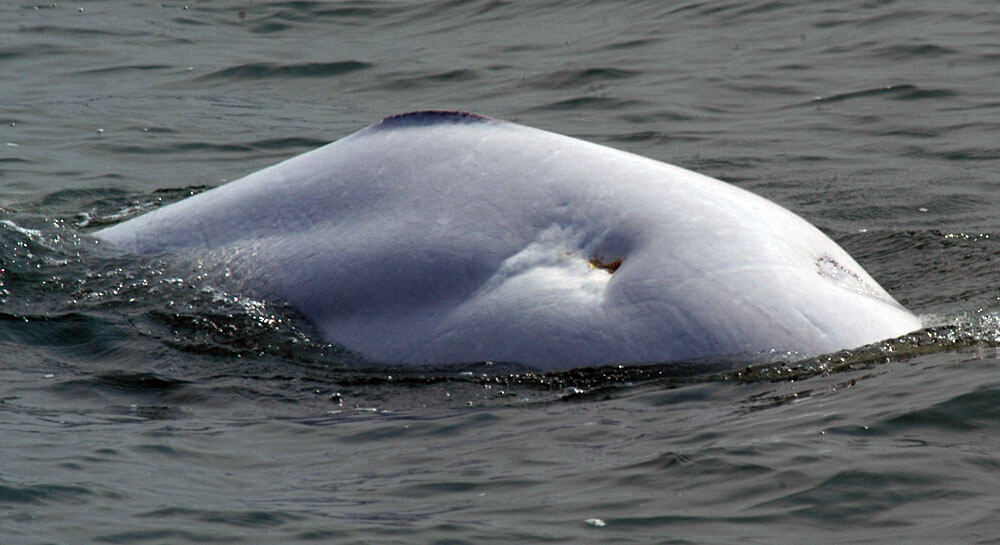Lula
Beluga


Adopted by the naturalists and the visitors of the Marine Mammals Interpretation Center
-
ID number
DL0129
-
Sex
Female
-
Year of birth
Circa 1985
-
Known Since
1991
Distinctive traits
Lula can be recognized from either side. Her right flank shows a sizable hole. A white, star-shaped spot can be seen near this hole. DL0129 also has a scar on her left flank, near the blowhole.
Life history
Our team first crossed paths with Lula in 1991. Based on the evolution of Lula’s colour pattern, we estimate that this individual was born around 1985. When she was first observed in 1991, Lula was still grey. Her change-over to white must have occurred during a period when we did not observe her. Indeed, we lost track of her between 2006 and 2017. Yet with such markings, this is rather surprising!
The areas frequented by Lula indicate that she belongs to the female community of the south shore of the St. Lawrence. Within their summer range, females form large communities in which they care for newborns and young.
In 2018, Lula is photographed by drone as part of the “Health Chart” research project. She becomes the first adopted beluga to also have aerial photos in her album!
Observations history in the Estuary
Years in which the animal was not observed Years in which the animal was observed
Latests news
Aboard the Bleuvet, we leave Tadoussac and head southwest. The research season is drawing to a close, so we are taking advantage of this windless, waveless day to fly the drone and take a few aerial photos of belugas. These photos are then analyzed to obtain measurements that help assess the animals’ physical fitness and monitor pregnancies. In this way, we wish to create a health chart for our belugas.
Off Cap au Saumon in the Charlevoix region, we spot a large herd at a considerable distance, but the closer we get, the more the belugas scatter. At last, we find a group of five to ten belugas that we photograph from the boat at the same time we take pictures of them with the drone. Back in the lab, we will cross-compare horizontal and vertical photos to learn to identify individuals from the air. Presently, we identify belugas with markings and scars on their flanks and dorsal ridges. We then find a new group, which contains a calf. We also note the presence of a beluga with deep scars: it is the female Lula. It’s a pleasant surprise to see her again, as she had not been photographed since 2006! We snap a photo of her from the air. Will we have a chance to photograph her again this year? Will we see an evolution of her size? The remainder of our research project will tell.
Sponsors
The naturalists of the GREMM and the visitors of the Marine Mammals Interpretation Center adopted Lula (2019).
Being a naturalist at the Group for Research and Education on Marine Mammals (GREMM) isn’t just our job, it’s a vocation, even a passion.
We welcome the public, talk to them about whales, tell them stories… we give them a unique experience. We teach them everything we know about the mysterious world of marine mammals, especially those that roam the St. Lawrence. In fact, there are several groups of interpreters and naturalists working for various organizations along the river. We all share the same passion.
Scientific education cannot exist without research. And we protect what we know. As we often say, the health of belugas is a reflection of the health of the St. Lawrence. It’s not just the health and balance of a fragile ecosystem that affects belugas. The river is a source of life, for us and for everything around us.
It’s been a long time coming : the return of “Adopt a Beluga” to support research into these majestic white whales. So, all naturalists, present, former and colleagues, let’s get together and adopt a beluga so that we too can do our part! We’ve chosen DL0584, a beluga that regularly frequents the mouth of the Saguenay. You’ll be able to observe him from the Marine Mammal Interpretation Center (CIMM) in Tadoussac and from the Site d’interprétation et d’observation de Pointe-Noire, on the other side of the fjord. Unfortunately, our beluga whale lost his life. However, GREMM has offered us a new beluga, DL0129. Because we need more knowledge to continue protecting them, let’s adopt a beluga!



